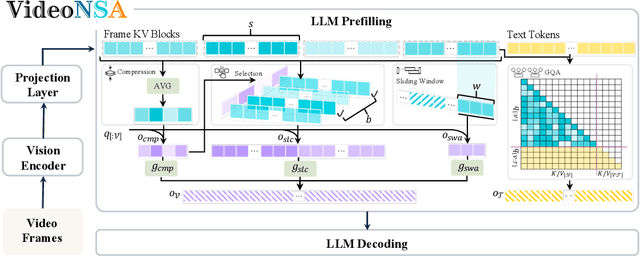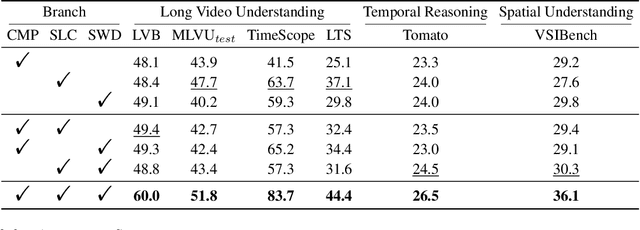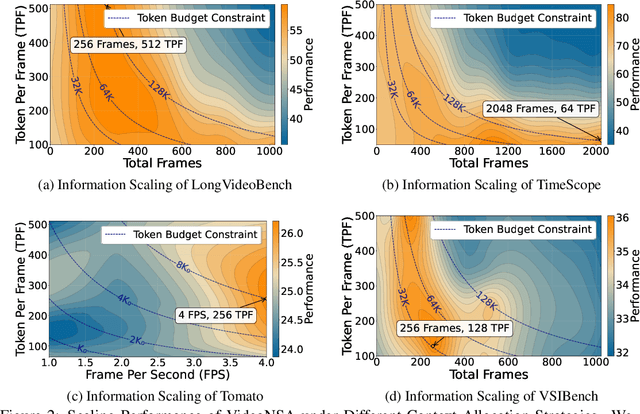Video Compression
Video compression is a process of reducing the size of an image or video file by exploiting spatial and temporal redundancies within an image or video frame and across multiple video frames. The ultimate goal of a successful Video Compression system is to reduce data volume while retaining the perceptual quality of the decompressed data.
Papers and Code
VALA: Learning Latent Anchors for Training-Free and Temporally Consistent
Oct 27, 2025Recent advances in training-free video editing have enabled lightweight and precise cross-frame generation by leveraging pre-trained text-to-image diffusion models. However, existing methods often rely on heuristic frame selection to maintain temporal consistency during DDIM inversion, which introduces manual bias and reduces the scalability of end-to-end inference. In this paper, we propose~\textbf{VALA} (\textbf{V}ariational \textbf{A}lignment for \textbf{L}atent \textbf{A}nchors), a variational alignment module that adaptively selects key frames and compresses their latent features into semantic anchors for consistent video editing. To learn meaningful assignments, VALA propose a variational framework with a contrastive learning objective. Therefore, it can transform cross-frame latent representations into compressed latent anchors that preserve both content and temporal coherence. Our method can be fully integrated into training-free text-to-image based video editing models. Extensive experiments on real-world video editing benchmarks show that VALA achieves state-of-the-art performance in inversion fidelity, editing quality, and temporal consistency, while offering improved efficiency over prior methods.
Diffusion Autoencoders with Perceivers for Long, Irregular and Multimodal Astronomical Sequences
Oct 23, 2025Self-supervised learning has become a central strategy for representation learning, but the majority of architectures used for encoding data have only been validated on regularly-sampled inputs such as images, audios. and videos. In many scientific domains, data instead arrive as long, irregular, and multimodal sequences. To extract semantic information from these data, we introduce the Diffusion Autoencoder with Perceivers (daep). daep tokenizes heterogeneous measurements, compresses them with a Perceiver encoder, and reconstructs them with a Perceiver-IO diffusion decoder, enabling scalable learning in diverse data settings. To benchmark the daep architecture, we adapt the masked autoencoder to a Perceiver encoder/decoder design, and establish a strong baseline (maep) in the same architectural family as daep. Across diverse spectroscopic and photometric astronomical datasets, daep achieves lower reconstruction errors, produces more discriminative latent spaces, and better preserves fine-scale structure than both VAE and maep baselines. These results establish daep as an effective framework for scientific domains where data arrives as irregular, heterogeneous sequences.
Real-Time Neural Video Compression with Unified Intra and Inter Coding
Oct 16, 2025Neural video compression (NVC) technologies have advanced rapidly in recent years, yielding state-of-the-art schemes such as DCVC-RT that offer superior compression efficiency to H.266/VVC and real-time encoding/decoding capabilities. Nonetheless, existing NVC schemes have several limitations, including inefficiency in dealing with disocclusion and new content, interframe error propagation and accumulation, among others. To eliminate these limitations, we borrow the idea from classic video coding schemes, which allow intra coding within inter-coded frames. With the intra coding tool enabled, disocclusion and new content are properly handled, and interframe error propagation is naturally intercepted without the need for manual refresh mechanisms. We present an NVC framework with unified intra and inter coding, where every frame is processed by a single model that is trained to perform intra/inter coding adaptively. Moreover, we propose a simultaneous two-frame compression design to exploit interframe redundancy not only forwardly but also backwardly. Experimental results show that our scheme outperforms DCVC-RT by an average of 10.7\% BD-rate reduction, delivers more stable bitrate and quality per frame, and retains real-time encoding/decoding performances. Code and models will be released.
Content-Adaptive Inference for State-of-the-art Learned Video Compression
Oct 08, 2025While the BD-rate performance of recent learned video codec models in both low-delay and random-access modes exceed that of respective modes of traditional codecs on average over common benchmarks, the performance improvements for individual videos with complex/large motions is much smaller compared to scenes with simple motion. This is related to the inability of a learned encoder model to generalize to motion vector ranges that have not been seen in the training set, which causes loss of performance in both coding of flow fields as well as frame prediction and coding. As a remedy, we propose a generic (model-agnostic) framework to control the scale of motion vectors in a scene during inference (encoding) to approximately match the range of motion vectors in the test and training videos by adaptively downsampling frames. This results in down-scaled motion vectors enabling: i) better flow estimation; hence, frame prediction and ii) more efficient flow compression. We show that the proposed framework for content-adaptive inference improves the BD-rate performance of already state-of-the-art low-delay video codec DCVC-FM by up to 41\% on individual videos without any model fine tuning. We present ablation studies to show measures of motion and scene complexity can be used to predict the effectiveness of the proposed framework.
TerraCodec: Compressing Earth Observations
Oct 14, 2025



Earth observation (EO) satellites produce massive streams of multispectral image time series, posing pressing challenges for storage and transmission. Yet, learned EO compression remains fragmented, lacking publicly available pretrained models and misaligned with advances in compression for natural imagery. Image codecs overlook temporal redundancy, while video codecs rely on motion priors that fail to capture the radiometric evolution of largely static scenes. We introduce TerraCodec (TEC), a family of learned codecs tailored to EO. TEC includes efficient image-based variants adapted to multispectral inputs, as well as a Temporal Transformer model (TEC-TT) that leverages dependencies across time. To overcome the fixed-rate setting of today's neural codecs, we present Latent Repacking, a novel method for training flexible-rate transformer models that operate on varying rate-distortion settings. Trained on Sentinel-2 data, TerraCodec outperforms classical codecs, achieving 3-10x stronger compression at equivalent image quality. Beyond compression, TEC-TT enables zero-shot cloud inpainting, surpassing state-of-the-art methods on the AllClear benchmark. Our results establish bespoke, learned compression algorithms as a promising direction for Earth observation. Code and model weights will be released under a permissive license.
MARC: Memory-Augmented RL Token Compression for Efficient Video Understanding
Oct 09, 2025The rapid progress of large language models (LLMs) has laid the foundation for multimodal models. However, visual language models (VLMs) still face heavy computational costs when extended from images to videos due to high frame rates and long durations. Token compression is a promising solution, yet most existing training-free methods cause information loss and performance degradation. To overcome this, we propose \textbf{Memory-Augmented Reinforcement Learning-based Token Compression (MARC)}, which integrates structured retrieval and RL-based distillation. MARC adopts a \textit{retrieve-then-compress} strategy using a \textbf{Visual Memory Retriever (VMR)} to select key clips and a \textbf{Compression Group Relative Policy Optimization (C-GRPO)} framework to distil reasoning ability from a teacher to a student model. Experiments on six video benchmarks show that MARC achieves near-baseline accuracy using only one frame's tokens -- reducing visual tokens by \textbf{95\%}, GPU memory by \textbf{72\%}, and latency by \textbf{23.9\%}. This demonstrates its potential for efficient, real-time video understanding in resource-constrained settings such as video QA, surveillance, and autonomous driving.
Hierarchical Indexing with Knowledge Enrichment for Multilingual Video Corpus Retrieval
Oct 10, 2025Retrieving relevant instructional videos from multilingual medical archives is crucial for answering complex, multi-hop questions across language boundaries. However, existing systems either compress hour-long videos into coarse embeddings or incur prohibitive costs for fine-grained matching. We tackle the Multilingual Video Corpus Retrieval (mVCR) task in the NLPCC-2025 M4IVQA challenge with a multi-stage framework that integrates multilingual semantics, domain terminology, and efficient long-form processing. Video subtitles are divided into semantically coherent chunks, enriched with concise knowledge-graph (KG) facts, and organized into a hierarchical tree whose node embeddings are generated by a language-agnostic multilingual encoder. At query time, the same encoder embeds the input question; a coarse-to-fine tree search prunes irrelevant branches, and only the top-ranked chunks are re-scored by a lightweight large language model (LLM). This design avoids exhaustive cross-encoder scoring while preserving chunk-level precision. Experiments on the mVCR test set demonstrate state-of-the-art performance, and ablation studies confirm the complementary contributions of KG enrichment, hierarchical indexing, and targeted LLM re-ranking. The proposed method offers an accurate and scalable solution for multilingual retrieval in specialized medical video collections.
An Empirical Study of Reducing AV1 Decoder Complexity and Energy Consumption via Encoder Parameter Tuning
Oct 14, 2025The widespread adoption of advanced video codecs such as AV1 is often hindered by their high decoding complexity, posing a challenge for battery-constrained devices. While encoders can be configured to produce bitstreams that are decoder-friendly, estimating the decoding complexity and energy overhead for a given video is non-trivial. In this study, we systematically analyse the impact of disabling various coding tools and adjusting coding parameters in two AV1 encoders, libaom-av1 and SVT-AV1. Using system-level energy measurement tools like RAPL (Running Average Power Limit), Intel SoC Watch (integrated with VTune profiler), we quantify the resulting trade-offs between decoding complexity, energy consumption, and compression efficiency for decoding a bitstream. Our results demonstrate that specific encoder configurations can substantially reduce decoding complexity with minimal perceptual quality degradation. For libaom-av1, disabling CDEF, an in-loop filter gives us a mean reduction in decoding cycles by 10%. For SVT-AV1, using the in-built, fast-decode=2 preset achieves a more substantial 24% reduction in decoding cycles. These findings provide strategies for content providers to lower the energy footprint of AV1 video streaming.
Generative World Modelling for Humanoids: 1X World Model Challenge Technical Report
Oct 08, 2025World models are a powerful paradigm in AI and robotics, enabling agents to reason about the future by predicting visual observations or compact latent states. The 1X World Model Challenge introduces an open-source benchmark of real-world humanoid interaction, with two complementary tracks: sampling, focused on forecasting future image frames, and compression, focused on predicting future discrete latent codes. For the sampling track, we adapt the video generation foundation model Wan-2.2 TI2V-5B to video-state-conditioned future frame prediction. We condition the video generation on robot states using AdaLN-Zero, and further post-train the model using LoRA. For the compression track, we train a Spatio-Temporal Transformer model from scratch. Our models achieve 23.0 dB PSNR in the sampling task and a Top-500 CE of 6.6386 in the compression task, securing 1st place in both challenges.
VideoNSA: Native Sparse Attention Scales Video Understanding
Oct 02, 2025



Video understanding in multimodal language models remains limited by context length: models often miss key transition frames and struggle to maintain coherence across long time scales. To address this, we adapt Native Sparse Attention (NSA) to video-language models. Our method, VideoNSA, adapts Qwen2.5-VL through end-to-end training on a 216K video instruction dataset. We employ a hardware-aware hybrid approach to attention, preserving dense attention for text, while employing NSA for video. Compared to token-compression and training-free sparse baselines, VideoNSA achieves improved performance on long-video understanding, temporal reasoning, and spatial benchmarks. Further ablation analysis reveals four key findings: (1) reliable scaling to 128K tokens; (2) an optimal global-local attention allocation at a fixed budget; (3) task-dependent branch usage patterns; and (4) the learnable combined sparse attention help induce dynamic attention sinks.
 Add to Chrome
Add to Chrome Add to Firefox
Add to Firefox Add to Edge
Add to Edge